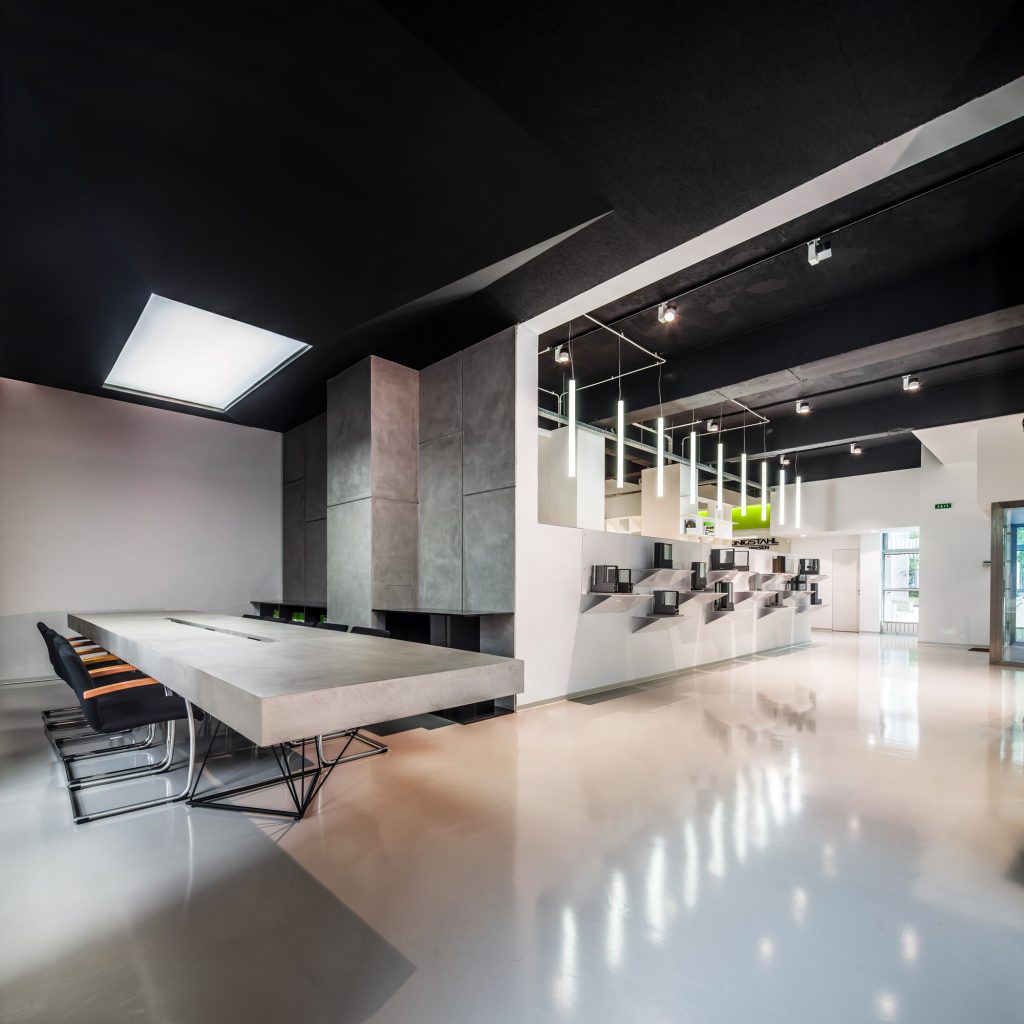What is microcement? What is a microcement floor? What difference is there between microcement and resin floors? At the first sight they seem very similar, both of them seamless, but they are two very different kinds of coatings for surfaces instead:
– The resin floor has an epoxy base with thermosetting polymers, it has a shiny effect and it can be subject to yellowing over time.
– The concrete floor and the microcement coatings have a cement base and are characterised by a higher tactility and a more natural effect; the microcement is not a resin, therefore it’s not subject to bubbles or yellowing. This cement coating can cover not only the floor, like the resin coating, but also any vertical surface, ceilings and many different additional elements.
WHAT ARE CONCRETE FLOORS?
A concrete floor (microcement) is a seamless floor made of a liquid polymer and a particular cement mix. Microcement first appeared in the United States, when some old factories started to be transformed into modern lofts and the microcement floor had been chosen to maintain that typical industrial concrete effect. It has later been chosen by some great fashion and sport brands to cover their stores, thanks to its qualities of extreme resistance to traffic and its great durability. Today the microcement is often used also at home, because it allows to create seamless surfaces and can be applied with a thickness of only 3 mm on different materials; it can be used to coat the floor, a wall, but also for unusual applications:
– Plasterboard and stonework walls
– Stairs
– Bath tubs and shower stalls
– Pieces of furniture
– Fireplaces
– Countertops
– Tables and other pieces of furniture
WHAT ARE RESIN FLOORS?
Resins for floors usually identify those floors one can obtain through the use of self-leveling resins and were initially used to protect the surfaces of factories and chemical laboratories, food industries, meat lockers and butcheries. Today, although their use is more suitable to the industrial field, epoxy resin is widespread also on a residential scale for its capacity to create seamless floors. Unlike the microcement coating, it has a shiny, plastic look, a lower wear resistance, and it tends to yellow over time.
DIFFERENCES AND SIMILARITIES BETWEEN CONCRETE AND RESIN FLOORS
To a non-expert look they can seem very similar, but the resin floor and the microcement floor are actually very different. The final result represents the main difference, since the resin floor has a shiny but plastic effect, whilst the microcement coating gives the floor a more natural and tactile effect. The microcement’s concrete effect is not to be underestimated because it is extremely customizable in the colour and in the effect, so the final result will overtake the classic grey and the surfaces will look unique and modern.
Besides the remarkable difference of the final result, the reasons to prefer a concrete coating are many:
– the microcement’s colour doesn’t undergo any change over time and therefore doesn’t turn yellow
– microcement can coat floors, walls, ceilings and many other elements
– resin is a plastic material which mainly results from the processing of petrol
However, these two decorative surfaces share some features, such as the following:
– They are both seamless modern floors with a continuous effect
– They are low thickness coatings (just a few millimeters)
– They can be customized in colours and effects (in different ways)
– They are resistant to weather conditions (through the use of specific protection treatments)
– They can be applied both indoor and outdoor
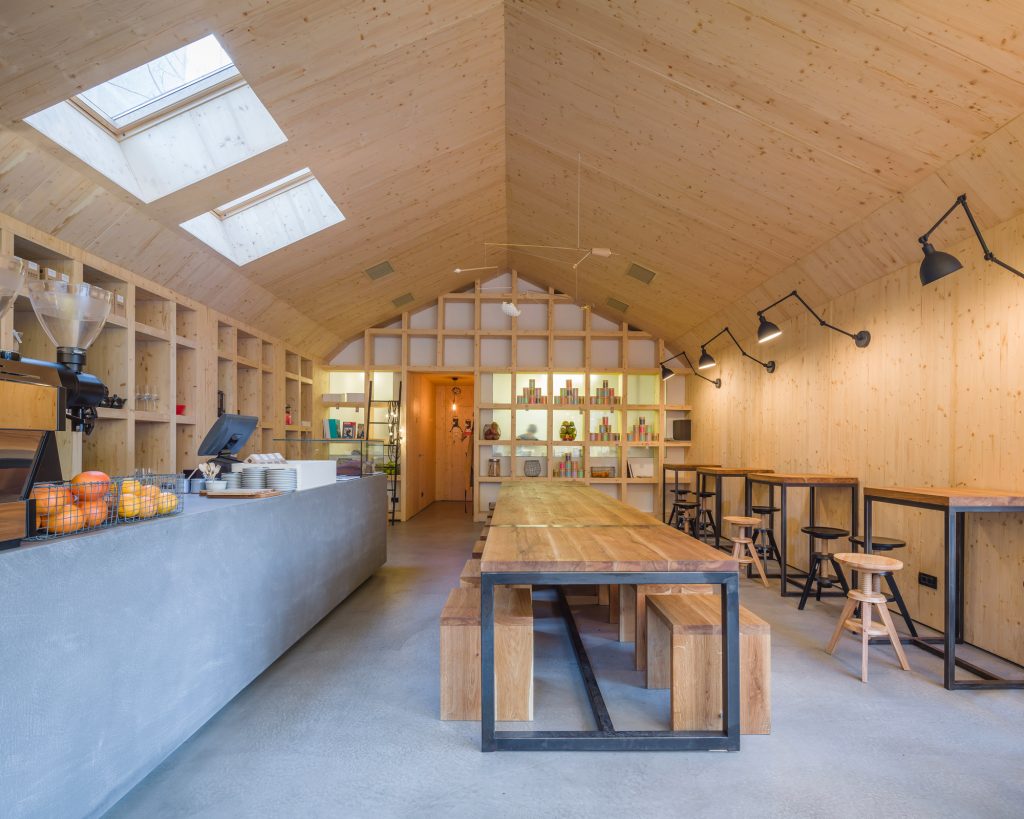
Let’s see in detail the common features and the main differences between these two fine modern coatings:
Microcement doesn’t turn yellow over time
One of resin floors’ main problems is the yellowing process over time, caused by a limited resistance to UV rays and to the sun’s effect. There are some retardant treatments but they don’t solve the problem and if one decides to install a resin floor, they must be aware that they will have to face the unease of a yellowed, anti-aesthetic floor.
With the microcement (Ideal Work’s Microtopping®), instead, it’s possible to create floors and coatings with a high resistance to UV rays and, thanks to some special protective treatments, these surfaces won’t undergo yellowing over time. This represents a great advantage compared to resin surfaces, because this way one can choose a very light colour without the risk of seeing it turning yellow as time goes by. Microcement, however, like all other kinds of materials (for example car’s paints), after a constat exposition to the sunlight or the moonlight might undergo a light modification of colour, which cannot be considered as a flaw though.
Covering a floor and much more with microcement
Microcement, or Microtopping® decorative microcement, allows the covering of both horizontal and vertical surfaces with just a 3 mm thickness. This makes it perfect for internal renovations, since it allows to quickly restore a floor without removing the old surface, whether it’s made of concrete, self-leveling, ceramic or wood. Its great ductility and capacity of cohesion to the substrate allow the application of decorative concrete on multiple materials. Moreover, with microcement it’s possible to cover not only floors and walls, but also unusual surfaces such as:
– Plasterboard and stonework walls
– Stairs
– Bath tubs and shower stalls
– Pieces of furniture
– Countertops
– Tables and other pieces of furniture
Compared to resin coatings, microcement is extremely ductile and it can therefore be used to cover anything, not only the floor as in the case of epoxy resin. This allows to decorate and modernise whole areas by following the same style.
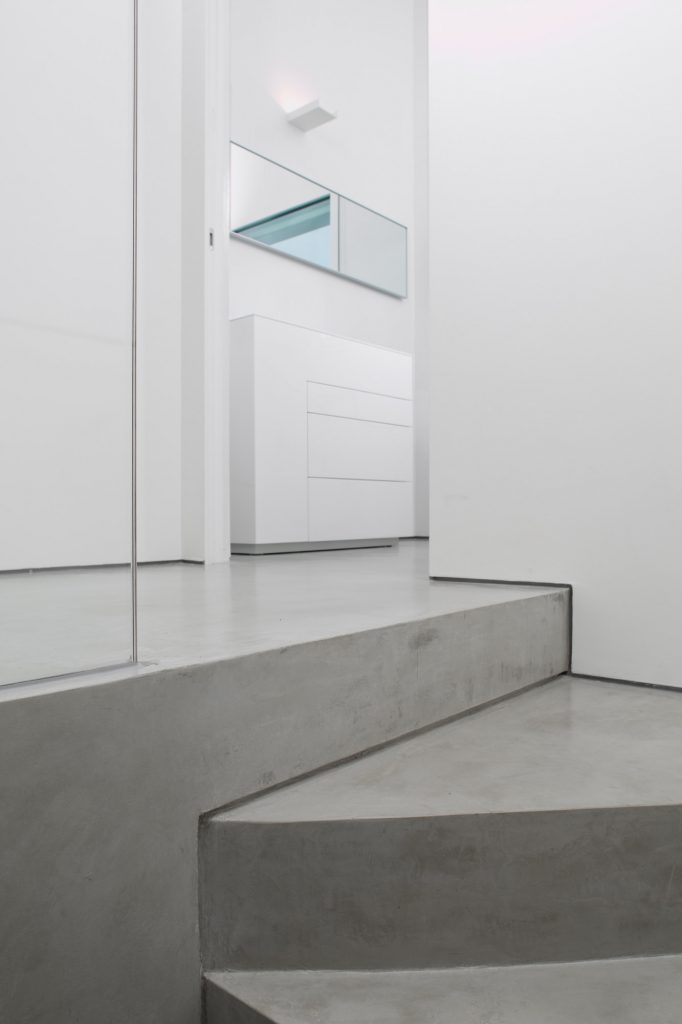
The two kinds of floor’s composition
Both are often chosen for internal restauration: resin and microcement have a very different composition though. Resin floors are composed of epoxy resin, which mainly results from the processing of petrol. It is therefore a plastic material. The concrete floor is composed of a cement mix with a small percentage of polymers which improves its ductility and its performance. The result is a concrete effect, tactile and velvety.
Weather conditions and UV rays resistance
The concrete floor, the microcement Microtopping®, guarantees a good protection from water penetration, climatic stress, thaw salts and UV rays. For this reason, the microcement floor is not only ideal for indoor, but also for outdoor applications such as:
– terraces
– sidewalks
– patios
– walls and external facades
Floors in epoxy resin, if treated with particular protections, are resistant to weather conditions too, but they suffer the damages resulting from the sunlight and UV rays, with a consequent yellowing process.
Seamless floors with a continuous effect
Amongst the various surface coatings, the microcement floor and the resin floor allow to create a seamless surface. A continuous surface is not only good-looking, it also gives the perception of enlarging the space, along with being easy and quick to clean. Compared to an epoxy resin, which allows to only create floors, the microcement flatwork Microtopping® allows to coat whole rooms with a continuous effect because it is applicable to walls and any other surface: on the bathroom surfaces, on the kitchen’s countertop, on the fireplace etc.
To obtain a seamless surface in your house it’s not necessary to demolish the old floor; a seamless floor doesn’t require the existing surfaces to be demolished to insert joints inside of them.
Greatly customizable colours, shades and effect
With a concrete floor one can obtain multiple combinations of colours and effects, all of which are customizable in the shade and intensity of colour. This is possible thanks to the handcrafted application by Ideal Work®’s authorized applicators. That’s why every Ideal Work® floor is unique; moreover, installing the floor in a handcrafted way allows to modify the final result of the shade and the intensity of the colour up until just before the application.
Resin is also available in many different colours, but with microcement the possible combinations are endless and suitable for all kinds of surfaces, floors and walls included. From white to different shades of grey, through various shades of brown and red, to brighter colours such as sky blue, aquamarine, lavender and many more. It is also possible to create a rough concrete effect floor, but also a wood effect, a semi-matt or a polish effect floor; the possible combinations are infinite and artisanal.
Check out Ideal Work’s microcement colours and customize your own choice!
Microcement’s practical applications
Microcement is an ideal solution to coat almost any surface, vertical or horizontal. Here are 4 projects by Ideal Work, showing how it is possible to coat walls and floors, from the kitchen to the bathroom, and even Ikea wooden kitchens, countertops, tables, pieces of furniture and much more:
Renovate your house’s floor and walls with microcement
A warm minimalism, geometries and combinations of white and grey for a house with an essential style where Ideal Work®’s microcement coating Microtopping® has been chosen for the kitchen’s walls, the stairs, the bathrooms and the basement’s floor.
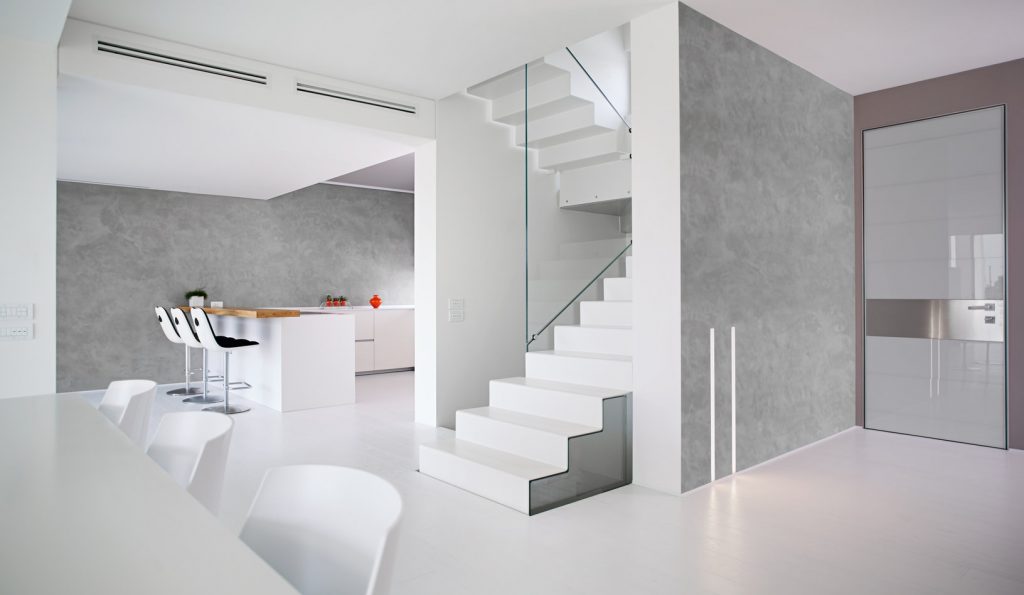
Coating a bathroom without demolishing the old surfaces
From a traditional bathroom to a modern one in a few weeks and without demolitions: it has been possible with Ideal Work®’s microcement coating Microtopping®, used here in its Smoke Grey colour on the entire surface.
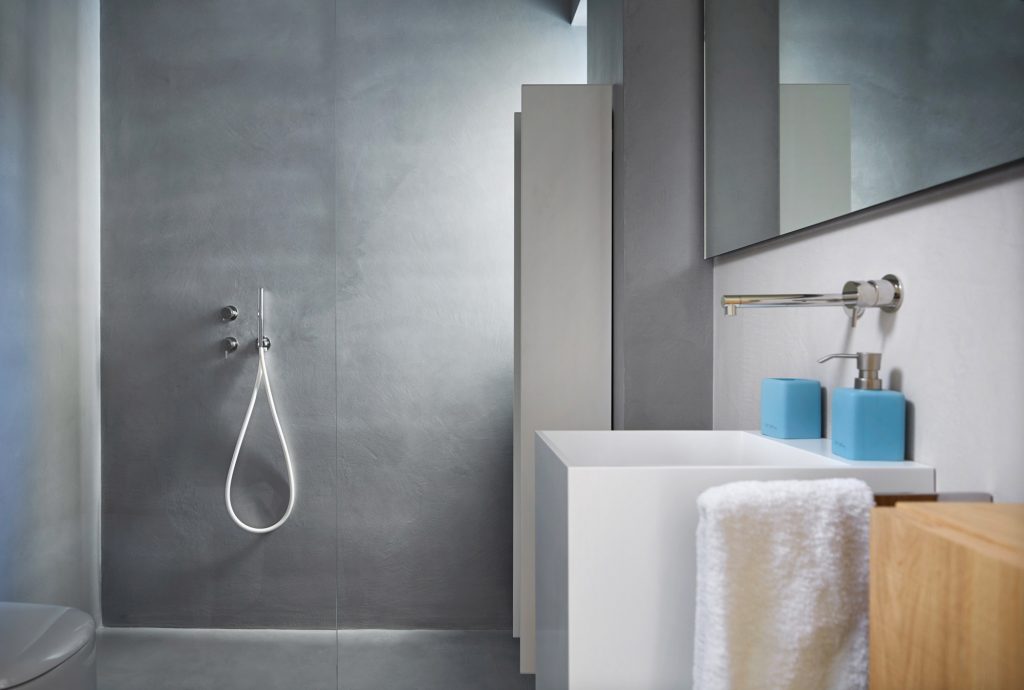
Covering a whole kitchen with microcement
To give the kitchen a new look: that’s what a young couple wanted to do, by customizing their Ikea kitchen countertop with a Neutral Grey microcement coating, resistant to high temperatures and therefore ideal to cover their wooden kitchen and make it unique.
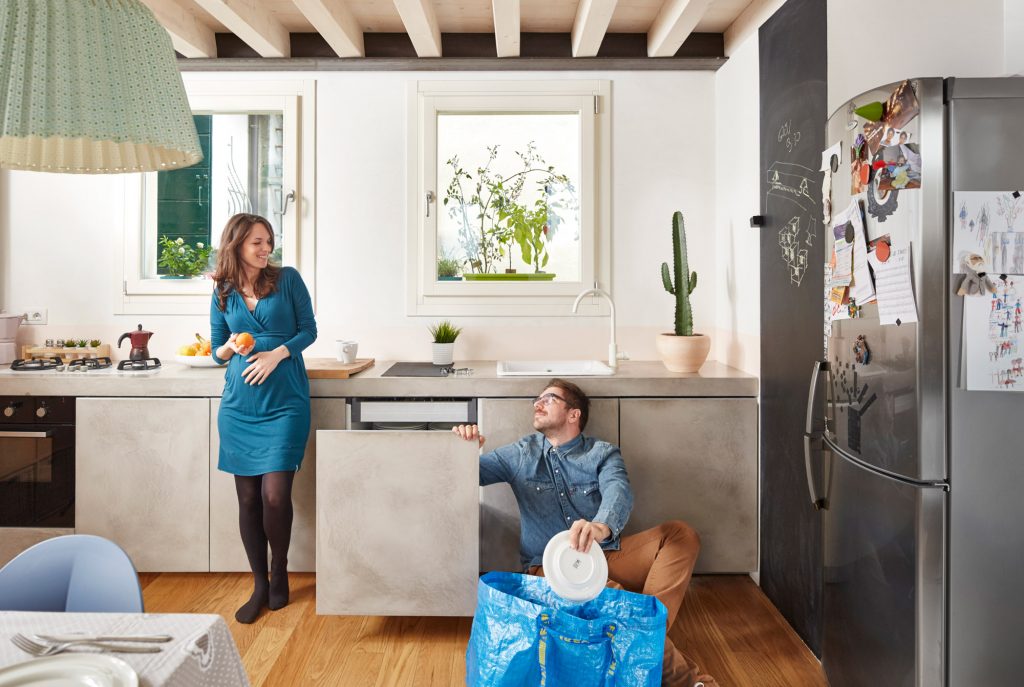
Covering a whole shoroom with microcement
Modernity and elegance for the Schüco showroon in Romania, where Microtopping® covers, in its Silver Grey shade, the walls and the table of the meeting room, highlighting the space with a super contemporary aesthetic.
